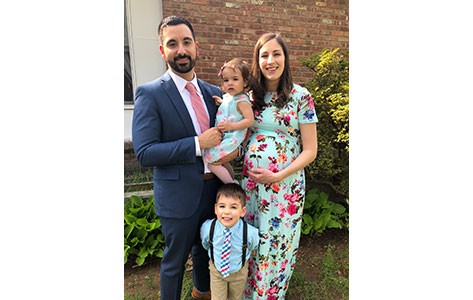As the chief of neurosurgery at Overlook Medical Center, Jay Chun, MD, PhD is used to performing spine surgeries on a single patient, but when he took on the case of Rita A., he was operating to save not one, but two lives.
Rita had been battling chronic back pain for several years, but it wasn’t until she was pregnant with her second child that she was no longer able to manage it.
“Spinal manipulation would usually do the trick to relieve my pain. I didn’t think it was a big deal – until I visited my chiropractor, and the pain would not subside. That’s when we both realized something was different,” says Rita.
Finding the root cause of the pain was no easy task because as a pregnant woman, there were limitations on tests she could undergo safely. Doctors performed ultrasounds on her body, and while it was clear her baby was healthy, the scans of her spine were inconclusive. They advised her to rest and get help to care for her two-year-old son, but the pain continued to worsen.
Desperate for help, Rita consulted a neurologist and with approval from her obstetrician-gynecologist (OB-GYN), she proceeded with a magnetic resonance imaging (MRI) scan. It revealed a massive tumor on her spine.

“Of course, I was scared. That’s an understatement. I’m only 28. I have a young family. I have a baby inside me and the realization quickly set in that there were no guarantees for either of us,” she says.
Although Rita tried to wait until after her pregnancy to seek treatment, it quickly became obvious that wouldn’t be an option. The tingling and weakness in her legs limited her mobility so severely that she could no longer perform basic tasks.
“Before I knew it, I couldn’t bathe myself, get dressed or walk by myself, or move my legs and feet. I couldn’t take care of myself, let alone my young son or my husband,” Rita says.
Abu Alam, MD, Rita’s OB-GYN, referred the emergency case to Dr. Chun, who had a reputation for dexterity and was not deterred by the complications pregnancy presented. The two doctors immediately worked together to design a surgical plan that would minimize the risks for both mom and baby.
“I was confident we could take the necessary precautions to protect Rita and her unborn daughter as we tried to get to the root of her pain and begin restoring her mobility,” says Dr. Chun, who has performed other surgeries on pregnant patients in the past. “It was clear this surgery could not wait, so we proceeded quickly, yet carefully, with this complex operation.”
Dr. Chun collaborated with a multi-disciplinary team of neuro-oncology, neuroradiology and neuropathology specialists, but due to tumor’s location, they weren’t sure it could be removed in one procedure. There was a strong possibility they would only be able to perform a biopsy, which meant a subsequent surgery and additional therapies would be needed to address the mass itself. Once surgery began, however, Dr. Chun found a way to remove the full tumor then and there.
“As we suspected, we discovered Rita had an ependymoma, which is a rare type of tumor that begins in the spine or the brain. Ependymomas like Rita’s are difficult to extract because the tumor can be embedded in the spine,” says Dr. Chun.
Just two days after the surgery, Rita’s pain started to subside and she was able to kick her feet. This small act was a big step forward that gave her hope as she started physical rehabilitation. Perhaps equally as important to regaining her mobility was the birth of her healthy daughter – an outcome that just months before had been in doubt. Now, the mother of two is expecting a third child and doing her best to make up for lost time.
“It’s crazy to think about where I was before surgery and where I am now,” Rita says. “It’s amazing that I don’t have back pain, that I can walk again and that I can play with my son and do so many things I missed out on for so many months.”
Request More Information
Please use the form to request more information.
All fields are required.
Please note that this form is for North American residents only.